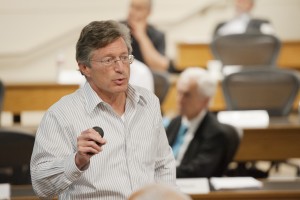The Faculty Senate heard an annual budget report from Provost John Etchemendy Ph.D. ’82 at its Thursday meeting.
“We are in good health financially,” Etchemendy summarized. “The budget also shows a lot of caution and concern for a lot of things on the horizon.”

Reviewing Stanford’s consolidated budget, Etchemendy noted that– despite increases in the financial aid budget, employee salaries and benefits, graduate student stipends and selected research funding– the University is projected to generate a surplus of $173 million for the 2013-14 fiscal year.
Turning to the general funds budget, which consists of unrestricted funds, Etchemendy said that budget would be used to increase the University’s reserve funds, remove the need to use buffer funds to support financial aid and increase research support.
Etchemendy also remarked on the University’s capital plan, which includes every project undertaken or completed over the next three years, drawing attention to Stanford’s continued growth.
“When I was an assistant professor here, I remember seeing all the construction and wondering when they were going to be done,” he said. “I realized Stanford is like a city. It’s never going to be done.”
While the capital budget for the 2013-14 fiscal year totals $658 million, Etchemendy estimated that only around 80 percent of that sum would actually be spent. Notable construction projects include the Stanford Energy System Innovations (SESI) project, which is slated to receive $207.9 million next year.
“[SESI involves] tearing up every street on campus and replacing the stream pipes with hot water pipes,” Etchemendy said. “We are going to end up with the most advanced energy system in the world but it’s going to cost us about $438 million [in total].”
Other significant construction projects include adding a fourth building– for bioengineering and chemical engineering– to the Engineering Quad, adding to the Stanford Hospital and the Lucile Packard Children’s Hospital, remodeling Roble Gym into an “arts gym,” remodeling the Old Chemistry building and adding a contemplative center to campus.
The University will also add more housing options to campus. The Comstock Graduate Housing project will add 362 beds for students, while the expansion of Graduate School of Business housing will add a further 150. A fourth dorm will be built in the Manzanita quad and two new dorms will be added to Lagunita.
There are also plans to add 180 housing units to Mayfield California Avenue for faculty and staff.
“This is something we desperately need,” Etchemendy said.
In faculty discussion following Etchemendy’s report, Professor of Development Biology Margaret Fuller queried whether the proposed additions to undergraduate housing would accommodate a potential desire to expand the undergraduate population.
“We would need something beyond that,” Etchemendy said. “Some of these new housing options will be used for the existing undergraduate population, but in order to grow the [population] further, we would need more housing.”